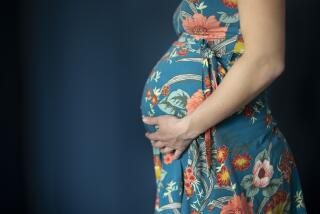In pregnancy, eating too much fish can raise a child’s obesity risk, study says

Fish is rich in Omega-3 fats that are good for fetal brain development. But a woman who eats too much fish during pregnancy may tip her child toward obesity, especially if the baby is a girl, says a new study.
- Share via
Newborns whose mothers ate fish more than three times a week during pregnancy grew faster in their first two years of life and were more likely to be overweight or obese at 4 and 6 years old than were babies born to mothers who ate little to no fish during pregnancy, a new study says.
In a large study conducted across several countries, researchers found that the weight-related effects of a mother’s high fish consumption was more pronounced when the offspring was female.
Researchers suggested two explanations for their finding: that the Omega-3 fatty acids found plentifully in fish might predispose fetal stem cells to differentiate into fat cells, or that pollutants found in fish disrupt fetal hormones related to metabolism and prompt greater fat storage. But they acknowledged that the possibility that contaminants are to blame for the effect is “speculative,” since the study’s authors had no measure of the persistent organic pollutants in the fish the women ate.
See the most-read stories in Science this hour >>
In July 2014, the Food and Drug Administration and the Environmental Protection Agency recommended that pregnant women eat two to three servings (8-12 ounces) of fish per week. The agencies’ advisory recommended that pregnant women steer clear of fish known to be contaminated with mercury (tilefish from the Gulf of Mexico, shark, swordfish and king mackerel, for example) and choose instead salmon, shrimp, pollock, light canned tuna, tipalia, catfish and cod.
The authors of the new study, published Monday in the journal JAMA Pediatrics, said their findings “are in line with” the EPA and FDA advisory.
The study tracked 26,184 pregnant women and their children, born between 1996 and 2011 in the United States and across Europe. They observed the growth patterns and weight status of the children up to the age of 6 years old. The pregnant women, who answered questionnaires about their food intake, reported they ate anywhere from less than half a serving of fish weekly (in the Netherlands, Belgium and Ireland) to as many as seven servings of fish per week (in Spain and Portugal).
The Massachusetts women that made up the U.S. study cohort ate an average of one to two servings of fish per week.
Join the conversation on Facebook >>
At 4 and 6 years old, children born to women who had had the highest level of fish consumption during pregnancy were 14% and 22% more likely to be overweight or obese than were babies born to women who ate the least fish. In their first two years of life, the babies of heavy fish eaters were 22% more likely to have had a rapid increase in growth than were the babies of women who ate little fish in pregnancy.
Largely scared by reports of mercury poisoning, U.S. women have been eating little fish during pregnancy, and public health campaigns have urged them to consumer more. Omega-3 fatty acids, which are plentiful in many kinds of fatty fish, are critical building blocks for the development of the fetal brain and retinal tissues. These essential fatty acids may also help determine the length of fetal gestation and ward off a mother’s depression during pregnancy or after giving birth.
Women who eat at least 12 ounces of oily fish per week have been shown to give birth to children who have better childhood IQ scores, fine motor coordination, and communication and social skills, along with other benefits.
But, as a 2014 article on the subject noted, the U.S. government’s new advice on fish consumption is “complicated.” The new research findings are likely to make it even more so, underscoring the importance of not eating too little or too much.
The authors of the current study — a team of researchers hailing from the 11 countries where women and their babies were participants — say the next step might be to try to better understand why a pregnant woman’s fish consumption, as well as other dietary patterns, appears to have different effects on a female baby than it does on a male child. They suggested that researchers should delve more closely into placental tissue to glean how intra-uterine factors such as diet could have sex-specific effects.
Follow me on Twitter @LATMelissaHealy and “like” Los Angeles Times Science & Health on Facebook.
MORE SCIENCE NEWS
Thirsty continents are slowing down expected sea level rise, scientists say
Way beyond diamonds: A look at some of the rarest minerals in the world
Your Neanderthal inheritance could affect your mood, your skin and your smoking habits







